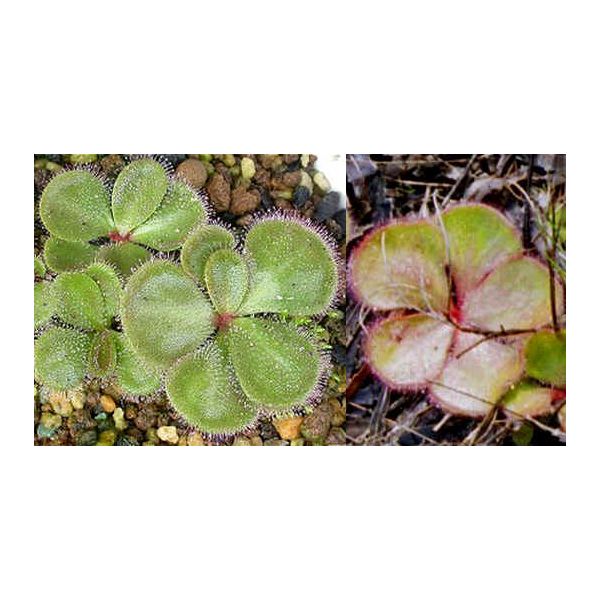Drosera Erythrorhiza Magna Seeds (Tuberous)
Drosera Erythrorhiza Magna Seeds (Tuberous)
Flowers from mid Winter to early Spring. In nature, Summer fire enhances flowering. The flowers are hermaphrodite.

Delivery
All orders shipped with UPS Express.
Always free shipping for orders over US $250.
All orders are shipped with a UPS tracking number.
Returns
Items returned within 14 days of their original shipment date in same as new condition will be eligible for a full refund or store credit.
Refunds will be charged back to the original form of payment used for purchase.
Customer is responsible for shipping charges when making returns and shipping/handling fees of original purchase is non-refundable.
All sale items are final purchases.
Help
Give us a shout if you have any other questions and/or concerns.
Email: contact@domain.com
Phone: +1 (23) 456 789
Availability: Out of stock
SKU
Drosera Erythrorhiza Magna
Drosera erythrorhiza magna occurs in North of Perth in Western Australia. This species has tubers underneath the ground. The plants sprout in the rainy season and form rosettes.
It's a tuberous, growing to 6" or more across. Leaves in a flat rosette with 4-6 round leaves. The leaves redden with age.
Flowers from mid Winter to early Spring. In nature, Summer fire enhances flowering. The flowers are hermaphrodite, they have both male and female organs.
It 's an insectivorous plant, it can survive in nitrogen poor soils because it gets the nutrients it needs from insects. The upper surfaces of leaves are covered with hairs that secrete a sweet sticky substance. This attracts insects, which become smeared with it and unable to escape. The plant then exudes a digestive fluid that enables it to absorb most of the insect into its system.
Growth occurs during the Winter months. It is important to respect the seasonal pattern of growth in cultivation. Once the plant starts to die back and enter dormancy the soil should be allowed to gradually dry out as the plant starts storing up energies in the tuber for the next season's growth. During the Summer months, reduce watering. Tuberous sundews can only be repotted when dormant, as the stem connecting the tuber to the soil surface is delicate.
Hardiness zones 9, (-5øC/25øF) in Winter. They should be grown in bright light, but with protection from full midday sun. In cloudy coastal areas, artificial light is preferable. Temperatures well above 25øC/78øF can cause them to die back and will kill seedlings. Temperatures should be kept between 20øC/25øC, 68øF/76øF. They require seasons in order to survive long term. They need a dormant period of about 3 months in Summer. At this time the compost should be allowed to dry slightly.
This plant variety can be successfully grown in areas where the soil quality is of a poor standard, but prefers a sandy peaty soil. A well drained soil is not required to successfully grow this variety. As long as the plants are kept cool and get lots of light, they are very tough and easy to grow. There's no need to fertilize, as the plant relies on insects for food.
Requires consistently moist soil; do not let dry out between waterings. This species will grow all year round if kept damp, making it ideally suited to beginners. They can also go dormant in the form of tubers during the dry season. The humidity should be between 60-80%.
Water must be distilled or rain water because they do not tolerate city or hard water. It is a good idea to place a pie pan or large saucer, with about an inch of water in it, under the pot. Elevate the pot by placing pebbles under it so that the base of the pot is barely in contact with the water, not submerged; the growing medium must stay moist, but never soggy. This will keep the humidity around the plant higher and it will ensure that the plant has a constant source of moisture.
| Common name | Red Ink Sundew |
|---|---|
| Species | Drosera erythrorhiza |
| Cultivar | magna |
| Germination | The seeds require 6 weeks hot stratification. Sow directly on the surface of your moist but not soaked soil mix. Do not cover them with any medium, the seeds are really tiny. After hot stratification, somewhat uncover the top of the pot, so that moisture and heat drop a little. Place the pot in an area with real nice strong light and keep the temperature around 20øC/68øF. When you see some tiny plants starting to sprout, slowly open the top of the pot, a little each day, so that the new seedlings don't go into shock from the humidity being lowered too quickly. After hot stratification, germination usually occurs in 1-3 months, but it can be prolonged up to several months, depending on their degree of unbroken dormancy, don't give up. Be very gentle with the new seedlings, not to destroy anything, it is very tiny. Make sure that it gets good air circulation. |
| Scarification / Stratification | It creates a hot and moist environment for the seeds. This will break their dormancy. Place the seeds on top of a prepared soil mix. Put the pots with seeds in plastic ziplock bags under but not too close to florescent lights. A temperature around 25øC / 76øF works best. Make sure to check the seeds often. If fungus or mold appears treat it with a fungicide. |
| Price View | Price Range |

